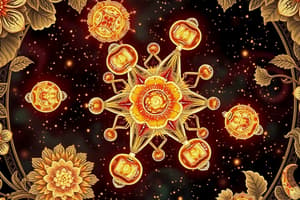Podcast
Questions and Answers
What is an atom?
What is an atom?
The smallest unit of an element that retains all its chemical properties when isolated.
What determines an atom's identity on the periodic table?
What determines an atom's identity on the periodic table?
The specific number of protons it has.
What is the electrical charge of most atoms?
What is the electrical charge of most atoms?
Neutral
Why is it difficult to observe individual atoms directly?
Why is it difficult to observe individual atoms directly?
What role do electrons play in determining an atom's chemical behavior?
What role do electrons play in determining an atom's chemical behavior?
Define a molecule and explain how it differs from an atom.
Define a molecule and explain how it differs from an atom.
How do atoms become charged ions, and what happens to their electrons in the process?
How do atoms become charged ions, and what happens to their electrons in the process?
Explain the significance of bonding in molecule formation.
Explain the significance of bonding in molecule formation.
What role do intermolecular forces play in stabilizing molecules?
What role do intermolecular forces play in stabilizing molecules?
Differentiate between the behaviors of individual atoms and molecules.
Differentiate between the behaviors of individual atoms and molecules.
Flashcards are hidden until you start studying
Study Notes
Atoms and Molecules: A Closer Look
Atoms and molecules form the building blocks of everything around us—from living organisms to the objects we see every day. Understanding these fundamental units can help you grasp the essence of chemistry's most basic functions. Let's delve into what atoms and molecules are, how they differ from one another, and how they interact with each other to create the world around us.
What is an Atom?
An atom is the smallest unit of an element that retains all its chemical properties when isolated. It consists of a nucleus containing protons and neutrons surrounded by electrons in energy levels called shells or orbitals. These electrons play a crucial role in determining an atom's chemical behavior. Each atom has a specific number of protons, which determine the atom's identity on the periodic table. Electrons have either a positive charge (+) or a negative charge (-), depending upon their position relative to the nucleus.
Key Points About Atoms:
- Size: An individual atom is extremely tiny, often smaller than a millionth of a millimeter in size. This makes it difficult to observe them directly without specialized equipment like electron microscopes.
- Electrical Charge: Most atoms have a neutral electrical charge since there are equal numbers of positively charged protons and negatively charged electrons. However, under certain conditions, some atoms gain extra electrons and become negatively charged ions; others lose electrons and become positively charged ions.
- Chemical Reactions: Chemical reactions occur because different types of atoms have different tendencies to share electrons. When two atoms bond together to form a compound, they do so by sharing electrons between themselves.
What is a Molecule?
A molecule is made up of at least two atoms joined together by covalent bonds. It represents the simplest combination of atoms that still preserve the essential characteristics of the substance itself. For example, water (H₂O) comprises just two hydrogen atoms and a single oxygen atom, yet it contains all the characteristic properties of liquid water.
Molecules come in various shapes and sizes, determined by the arrangement of their constituent atoms. They may resemble simple structures such as linear chains or more complex arrangements known as clusters. Just as atoms bond through shared electrons, individual molecules also link together via covalent or ionic bonds to form compounds or larger structures like polymers.
Here are some key aspects of molecules:
- Bonding: A molecule forms due to the attraction between opposite charges within the atoms involved; this results in a stable structure.
- Intermolecular Forces: Unlike atoms, which have strong forces holding them together, molecules rely on weak interatomic forces such as van der Waals forces for stability.
- Structure and Properties: The shape and composition of molecules heavily influence their physical and chemical behavior, including boiling points, solubility, etc..
Differences Between Atoms and Molecules
While there are similarities between atoms and molecules, they differ significantly in several ways:
- Composition: Atoms consist of only one type of element, whereas molecules are composed of multiple elements combined according to fixed proportions.
- Behavior: Individual atoms exhibit independent behaviors because of their unique locations within matter. On the other hand, molecules behave collectively and display group properties.
- Size and Structure: Atoms are generally much smaller than molecules, making them hard to distinguish visually. However, both components contain protons and neutrons inside the nucleus along with surrounding electrons.
In summary, understanding atoms and molecules helps us comprehend why materials possess distinct qualities and how they interact with each other. From the tiniest particles to the largest biological systems, our knowledge of atomic and molecular interactions forms the foundation of modern science.
Studying That Suits You
Use AI to generate personalized quizzes and flashcards to suit your learning preferences.




